The global electric motor market is valued at USD 150.9 billion in 2025 and is slated to reach USD 285.9 billion by 2035, recording an absolute increase of USD 135.0 billion over the forecast period. This translates into a total growth of 89.5%, with the market forecast to expand at a compound annual growth rate (CAGR) of 6.6% between 2025 and 2035. As per Future Market Insights, a top research partner for Fortune 1000 companies, the overall market size is expected to grow by nearly 1.9X during the same period, supported by accelerating electric vehicle adoption, expanding industrial automation, and rising demand for energy-efficient motor solutions across diverse manufacturing and commercial applications.
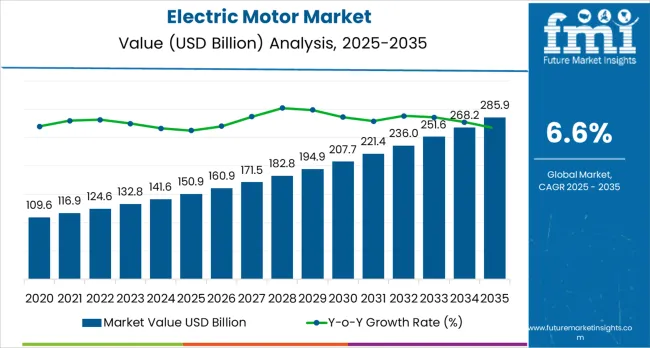
Between 2025 and 2030, the electric motor market is projected to expand from USD 150.9 billion to USD 207.7 billion, resulting in a value increase of USD 56.8 billion, which represents 42.1% of the total forecast growth for the decade. This phase of development will be shaped by increasing electric vehicle production, rising industrial automation investments, and growing demand for energy-efficient motor technologies in manufacturing and commercial applications. Equipment manufacturers are expanding their production capabilities to address the growing demand for brushless DC motors and enhanced operational reliability.
| Metric | Value |
|---|---|
| Estimated Value in (2025E) | USD 150.9 billion |
| Forecast Value in (2035F) | USD 285.9 billion |
| Forecast CAGR (2025 to 2035) | 6.6% |
From 2030 to 2035, the market is forecast to grow from USD 207.7 billion to USD 285.9 billion, adding another USD 78.2 billion, which constitutes 57.9% of the overall ten-year expansion. This period is expected to be characterized by the expansion of smart motor technologies, the integration of IoT connectivity and digital monitoring systems, and the development of advanced permanent magnet motor technologies for electric vehicle and industrial applications. The growing adoption of renewable energy projects and automated manufacturing processes will drive demand for electric motors with enhanced efficiency characteristics and reduced environmental impact.
Between 2020 and 2025, the electric motor market experienced robust growth, driven by increasing electric vehicle adoption and growing recognition of electric motors as essential components for industrial automation and energy-efficient operations. The market developed as manufacturers and system integrators recognized the potential for advanced motor technologies to enhance operational efficiency while reducing energy consumption and improving performance reliability. Technological advancement in brushless DC motors and smart control systems began emphasizing the critical importance of maintaining precision control and energy efficiency in motor applications.
Market expansion is being supported by the increasing global demand for electric vehicles and the corresponding need for efficient propulsion systems that can maintain operational reliability and performance standards while supporting diverse automotive and industrial applications across various operational environments. Modern automotive manufacturers and industrial facilities are increasingly focused on implementing motor solutions that can reduce energy consumption, minimize maintenance requirements, and provide consistent performance in demanding operational conditions. Electric motors'proven ability to deliver enhanced energy efficiency, reliable operational capabilities, and versatile application usage make them essential equipment for contemporary electric vehicle production and industrial automation solutions.
The growing emphasis on environmental compliance and energy efficiency is driving demand for electric motors that can support advanced manufacturing systems, reduce operational costs, and enable efficient automation across varying production requirements. Industrial users'preference for equipment that combines precision control with energy efficiency and cost-effectiveness is creating opportunities for innovative motor implementations. The rising influence of Industry 4.0 technologies and smart manufacturing systems is also contributing to increased adoption of electric motors that can provide advanced operational control without compromising performance or reliability standards.
The electric motor market is poised for robust growth and transformation. As automotive manufacturers and industrial operations across both developed and emerging markets seek propulsion and automation equipment that is efficient, reliable, precise, and environmentally compliant, electric motor systems are gaining prominence not just as mechanical components but as strategic infrastructure for operational efficiency, energy management, performance optimization, and environmental compliance.
Rising electric vehicle adoption and industrial automation in Asia Pacific, North America, and Europe amplify demand, while manufacturers are picking up on innovations in brushless technologies and smart connectivity systems.
Pathways like brushless DC motor adoption, IoT integration, and smart manufacturing connectivity promise strong margin uplift, especially in developed markets. Geographic expansion and application diversification will capture volume, particularly where automotive and industrial infrastructure require modernization. Industry pressures around energy efficiency, performance reliability, emission reduction, and automation advancement give structural support.
The market is segmented by product, power output, application, end-use industry, and region. By product, the market is divided into AC motors (induction and synchronous) and DC motors (brushed and brushless). By power output, it covers <1HP, 1-5HP, 5-10HP, 10-20HP, 20-50HP, 50-100HP, 100-300HP, 300-500HP, and above 500HP. By application, it includes pumps, fans, drives, compressors, general machinery, centrifugal machinery, grinders, extruders, robotics, and others. By end-use industry, it is segmented into industrial, residential, HVAC &refrigeration, medical, municipal water treatment, transportation, and others. Regionally, the market is divided into North America, Latin America, Western Europe, Eastern Europe, East Asia, South Asia Pacific, and Middle East &Africa.
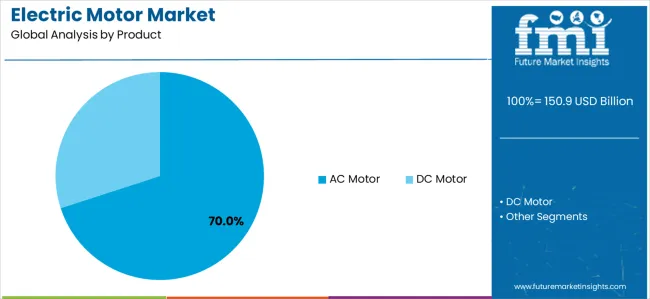
The AC motors segment is projected to account for 70.0% of the electric motor market in 2025, reaffirming its position as the leading product category. Industrial operators and automotive manufacturers increasingly utilize AC motors for their proven reliability, established cost-effectiveness, and superior performance in power conversion across industrial automation, electric vehicle, and commercial applications. AC motor technology's established operational procedures and robust performance output directly address the industrial requirements for reliable power delivery and operational efficiency in diverse manufacturing environments.
This product segment forms the foundation of current industrial and automotive operations, as it represents the technology with the greatest operational reliability and established maintenance infrastructure across multiple applications and power scenarios. Operator investments in enhanced AC motor systems and efficiency optimization continue to strengthen adoption among manufacturers and automotive companies. With operators prioritizing operational reliability and energy efficiency, AC motors align with both performance objectives and cost management requirements, making them the central component of comprehensive electrification strategies.
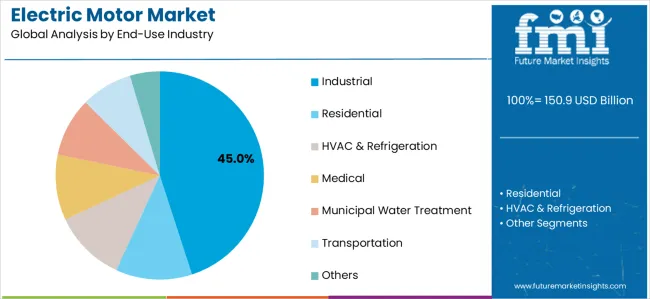
Industrial end-use industry is projected to represent 45.0% of electric motor demand in 2025, underscoring its critical role as the primary application for manufacturing automation and industrial process operations. Industrial operators prefer electric motors for their efficiency, reliability, and ability to handle demanding operational requirements while supporting production schedules and operational efficiency objectives. Positioned as essential equipment for modern industrial operations, electric motors offer both operational advantages and energy benefits.
The segment is supported by continuous innovation in industrial automation expansion and the growing availability of specialized motor configurations that enable efficient operation with enhanced precision control capabilities. Additionally, industrial facilities are investing in motor optimization to support large-scale operations and production efficiency delivery. As industrial automation becomes more prevalent and operational efficiency requirements increase, industrial applications will continue to dominate the end-use market while supporting advanced motor utilization and manufacturing strategies.
The electric motor market is advancing steadily due to increasing electric vehicle adoption and growing implementation of advanced industrial automation infrastructure that provides enhanced operational efficiency and performance reliability across diverse automotive and manufacturing applications. The market faces challenges, including high costs of advanced motor technologies, raw material price volatility for rare earth materials, and varying operational requirements across different application environments. Innovation in brushless technologies and smart connectivity systems continues to influence motor development and market expansion patterns.
The growing expansion of electric vehicle production and industrial automation implementation is enabling motor manufacturers to develop electric motor systems that provide superior energy efficiency, enhanced performance capabilities, and reliable operation in demanding automotive and manufacturing environments. Advanced electric motor systems provide improved operational capacity while allowing more effective power conversion and consistent performance delivery across various applications and operational requirements. Manufacturers are increasingly recognizing the competitive advantages of modern motor capabilities for operational efficiency and system performance positioning.
Modern electric motor manufacturers are incorporating smart connectivity systems and IoT monitoring technologies to enhance operational precision, reduce maintenance requirements, and ensure consistent performance delivery to automotive and industrial operators. These technologies improve system efficiency while enabling new applications, including predictive maintenance and automated performance optimization solutions. Advanced technology integration also allows manufacturers to support premium motor positioning and operational optimization beyond traditional motor supply.
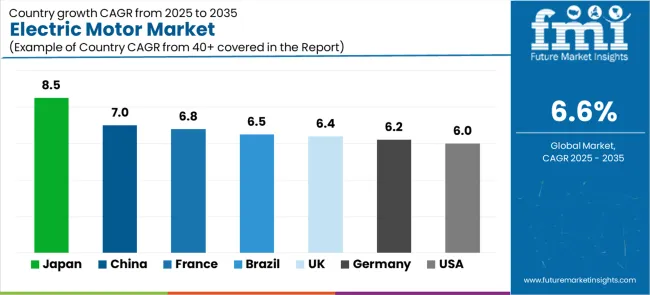
| Country | CAGR (2025-2035) |
|---|---|
| Japan | 8.5% |
| China | 7.0% |
| France | 6.8% |
| Brazil | 6.5% |
| United Kingdom | 6.4% |
| Germany | 6.2% |
| United States | 6.0% |
The electric motor market is experiencing robust growth globally, with Japan leading at an 8.5% CAGR through 2035, driven by advanced manufacturing automation, electric vehicle development leadership, and stringent energy efficiency regulations supported by technological innovation and precision engineering capabilities. China follows at 7.0%, supported by massive electric vehicle production scale, industrial automation expansion, and growing adoption of motor technologies. France shows growth at 6.8%, emphasizing renewable energy infrastructure and industrial modernization. Brazil demonstrates 6.5% growth, driven by expanding industrial base and infrastructure development. United Kingdom records 6.4%, focusing on renewable energy integration and manufacturing efficiency. Germany shows 6.2% growth, supported by automotive excellence and industrial automation. USA demonstrates 6.0% growth, driven by electric vehicle infrastructure but constrained by mature market conditions.
The report covers an in-depth analysis of 40+ countries;seven top-performing countries are highlighted below.
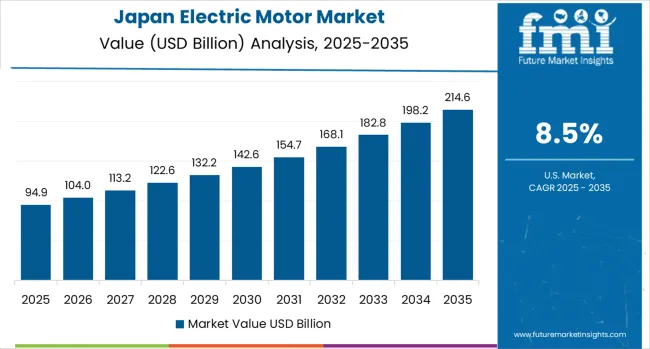
Revenue from electric motors in Japan is projected to exhibit exceptional growth with a CAGR of 8.5% through 2035, driven by advanced manufacturing automation programs and electric vehicle development leadership supported by technological innovation and precision engineering capabilities. The country's comprehensive industrial automation strategy and increasing investment in electric vehicle technologies are creating substantial demand for advanced motor solutions. Major automotive companies and industrial manufacturers are establishing extensive equipment operations to address the growing demand for efficient motors and performance optimization.
Revenue from electric motors in China is expanding at a CAGR of 7.0%, supported by the country's dominant electric vehicle manufacturing position, extensive industrial automation expansion, and increasing adoption of advanced motor technologies. The country's comprehensive automotive electrification strategy and growing industrial development are driving sophisticated motor capabilities. State manufacturers and automotive companies are establishing extensive equipment operations to address the growing demand for efficient propulsion systems and industrial automation.
Revenue from electric motors in France is expanding at a CAGR of 6.8%, supported by the country's renewable energy infrastructure development, comprehensive industrial modernization programs, and strategic investment in automation advancement. The nation's established manufacturing sector and increasing emphasis on energy efficiency are driving sophisticated motor capabilities throughout the equipment market. Leading industrial operators and energy companies are investing extensively in motor technology development and system integration to serve both domestic manufacturing needs and renewable energy markets.
Revenue from electric motors in Brazil is expanding at a CAGR of 6.5%, supported by the country's expanding industrial base, infrastructure development programs, and growing investment in manufacturing modernization. Brazil's developing automotive sector and emphasis on industrial improvement are driving demand for reliable motor technologies across major industrial markets. Manufacturing companies and industrial operators are establishing equipment partnerships to serve both domestic industrial development and export manufacturing requirements.
Revenue from electric motors in the United Kingdom is growing at a CAGR of 6.4%, driven by expanding renewable energy integration programs, increasing manufacturing efficiency requirements, and growing investment in industrial automation. The country's established industrial infrastructure and emphasis on energy efficiency are supporting demand for advanced motor technologies across major manufacturing markets. Industrial operators and energy companies are establishing comprehensive equipment programs to serve both domestic manufacturing needs and renewable energy development requirements.
Revenue from electric motors in Germany is expanding at a CAGR of 6.2%, supported by the country's automotive manufacturing leadership, advanced industrial automation capabilities, and comprehensive manufacturing modernization programs among automotive operators. The nation's established automotive sector and increasing emphasis on electrification are driving sophisticated motor capabilities throughout the manufacturing market. Leading automotive manufacturers and industrial facilities are investing extensively in motor technology development and system integration to serve both domestic automotive needs and export markets.
Revenue from electric motors in the USA is expanding at a CAGR of 6.0%, supported by the country's electric vehicle infrastructure development, industrial automation programs, and strategic investment in manufacturing modernization. USA's established automotive industry and emphasis on electrification advancement are driving demand for motor technologies across major automotive markets. Automotive manufacturers and industrial facilities are establishing equipment partnerships to serve both domestic vehicle production and industrial automation requirements.
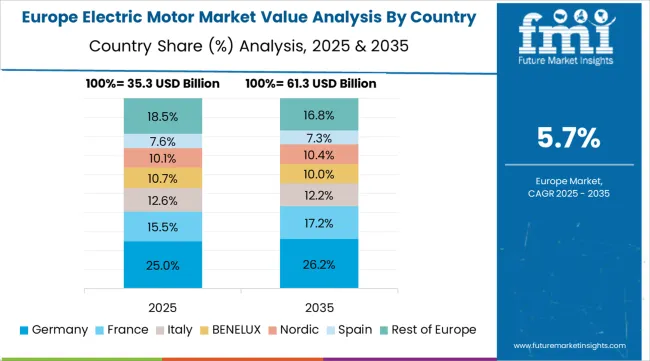
The electric motor market in Europe is projected to grow from USD 42.8 billion in 2025 to USD 79.6 billion by 2035, registering a CAGR of 6.4% over the forecast period. Germany is expected to maintain its leadership position with a 31.2% market share in 2025, increasing to 32.1% by 2035, supported by its advanced automotive manufacturing capabilities, comprehensive industrial automation infrastructure, and major electric vehicle development serving European and international markets.
France follows with a 18.7% share in 2025, projected to reach 19.2% by 2035, driven by renewable energy infrastructure development, industrial modernization programs, and established manufacturing capabilities, supported by government investment in electrification technologies. United Kingdom holds a 16.4% share in 2025, expected to decline to 15.9% by 2035, supported by renewable energy integration and manufacturing efficiency initiatives but facing challenges from economic uncertainties. Italy commands a 13.1% share in 2025, projected to reach 13.3% by 2035, while Spain accounts for 10.8% in 2025, expected to reach 10.9% by 2035. The Rest of Europe region, including Nordic countries, Eastern European markets, Netherlands, Belgium, and other European countries, is anticipated to maintain momentum, with its collective share remaining stable from 9.8% to 8.6% by 2035, attributed to steady industrial development across Nordic countries and consistent manufacturing modernization across various European markets implementing automation upgrade programs.
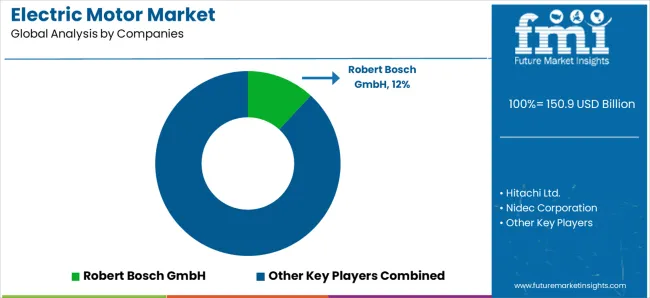
The electric motor market is being shaped by a diverse range of global players across industrial, automotive, and consumer sectors, with competition primarily defined by motor efficiency, performance, and technology integration. Robert Bosch GmbH holds approximately 12% of the market, Siemens AG captures around 11%, and ABB Group leads with a share of 10%. These companies dominate by providing advanced electric motor solutions that cater to industrial automation, automotive applications, and energy-efficient systems. Bosch and Siemens emphasize high-performance, compact motor technologies integrated into smart automation and control systems, while ABB focuses on sustainable electric motor designs for various sectors, including renewable energy and heavy industry. Hitachi Ltd. holds approximately 8% of the market share, while Nidec Corporation captures around 7%, driving growth with a focus on the automotive sector, home appliances, and power generation. Nidec is particularly strong in precision motors and small motors, whereas Hitachi targets large industrial motors. WEG S.A. holds about 6% and Johnson Electric accounts for 5%, both recognized for their global presence and reliable motor technologies in HVAC, robotics, and other industrial applications. Hyosung Corporation holds around 4%, Schneider Electric SE has 3%, and Bonfiglioli Riduttori S.p.A. captures approximately 3% of the market, catering to niche markets such as power transmission, renewable energy, and energy management, with a focus on integration and smart control systems. Competition is driven by technological advancements, energy efficiency, and the growing demand for electric vehicles and automation solutions.
Product brochures are being crafted to highlight motor performance, technological advantages, and industry-specific applications. Bosch, Siemens, and ABB brochures emphasize their broad range of electric motors, focusing on energy efficiency, reliability, and integration with digital solutions for industrial and automotive sectors. Hitachi and Nidec brochures showcase their precision motor technologies, with clear visuals of applications in consumer electronics, automotive, and industrial automation. WEG and Johnson Electric brochures highlight product durability, application versatility, and energy-saving features. Hyosung, Schneider Electric, and Bonfiglioli brochures focus on specialized motor technologies for renewable energy and power transmission, showcasing their efficiency and integration with smart grid systems. Each brochure is designed to serve as an informative, concise reference that ensures electric motor solutions are presented with clarity, credibility, and immediate value to industrial clients, OEMs, and system integrators.
| Items | Values |
|---|---|
| Quantitative Units (2025) | USD 150.9 billion |
| Product | AC Motor (Induction Motor, Synchronous Motor), DC Motor (Brushed DC, Brushless DC) |
| Power Output | <1HP, 1-5HP, 5-10HP, 10-20HP, 20-50HP, 50-100HP, 100-300HP, 300-500HP, Above 500HP |
| Application | Pumps, Fans, Drives, Compressors, General Machinery, Centrifugal Machinery, Grinders, Extruders, Robotics, Others |
| End-Use Industry | Industrial, Residential, HVAC &Refrigeration, Medical, Municipal Water Treatment, Transportation, Others |
| Regions Covered | North America, Latin America, Western Europe, Eastern Europe, East Asia, South Asia Pacific, Middle East &Africa |
| Countries Covered | United States, Canada, Germany, United Kingdom, France, China, Japan, Brazil, India and 40+ countries |
| Key Companies Profiled | Robert Bosch GmbH, Hitachi Ltd., Nidec Corporation, WEG S.A., Siemens AG, and ABB Group |
| Additional Attributes | Motor sales by product type and end-use industry, regional demand trends, competitive landscape, technological advancements in brushless systems, smart connectivity development, IoT integration innovation, and energy efficiency optimization |
The global electric motor market is estimated to be valued at USD 150.9 billion in 2025.
The market size for the electric motor market is projected to reach USD 285.9 billion by 2035.
The electric motor market is expected to grow at a 6.6% CAGR between 2025 and 2035.
The key product types in electric motor market are ac motor and dc motor.
In terms of end-use industry, industrial segment to command 45.0% share in the electric motor market in 2025.






Full Research Suite comprises of:
Market outlook & trends analysis
Interviews & case studies
Strategic recommendations
Vendor profiles & capabilities analysis
5-year forecasts
8 regions and 60+ country-level data splits
Market segment data splits
12 months of continuous data updates
DELIVERED AS:
PDF EXCEL ONLINE
Electric Motors Market Size and Share Forecast Outlook 2025 to 2035
Electric Motorcycles And Scooters Market Size and Share Forecast Outlook 2025 to 2035
Electric Motor Horn Market Growth – Trends & Forecast 2025 to 2035
Electric Motors For Conveyor System Market
Electric Vehicle Motor Market Forecast and Outlook 2025 to 2035
Electric Traction Motor Market Forecast Outlook 2025 to 2035
Electric Power Steering Motors Market Size and Share Forecast Outlook 2025 to 2035
Electric Commercial Vehicle Traction Motor Market Size and Share Forecast Outlook 2025 to 2035
AC Electric Motor Market Size and Share Forecast Outlook 2025 to 2035
Premium Electric Motorcycle Market Size and Share Forecast Outlook 2025 to 2035
Aircraft Electric Motor Market Forecast Outlook 2025 to 2035
Aircraft Electric Motors Market Size and Share Forecast Outlook 2025 to 2035
Electric Vehicle Sensor Market Forecast and Outlook 2025 to 2035
Electric Off-Road ATVs & UTVs Market Size and Share Forecast Outlook 2025 to 2035
Electric Blind Rivet Gun Market Size and Share Forecast Outlook 2025 to 2035
Electric Fireplace Market Size and Share Forecast Outlook 2025 to 2035
Electric Glider Market Size and Share Forecast Outlook 2025 to 2035
Electric Vehicle Battery Conditioners Market Size and Share Forecast Outlook 2025 to 2035
Electric Gripper Market Size and Share Forecast Outlook 2025 to 2035
Electric Boat Market Size and Share Forecast Outlook 2025 to 2035

Thank you!
You will receive an email from our Business Development Manager. Please be sure to check your SPAM/JUNK folder too.
Chat With
MaRIA